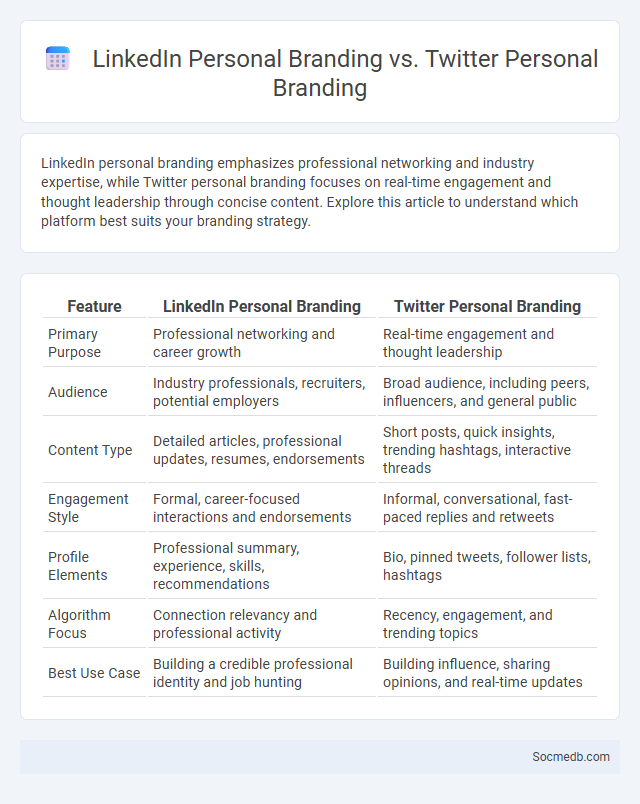
Photo illustration: LinkedIn Personal Branding vs Twitter Personal Branding
LinkedIn personal branding emphasizes professional networking and industry expertise, while Twitter personal branding focuses on real-time engagement and thought leadership through concise content. Explore this article to understand which platform best suits your branding strategy.
Table of Comparison
| Feature | LinkedIn Personal Branding | Twitter Personal Branding |
|---|---|---|
| Primary Purpose | Professional networking and career growth | Real-time engagement and thought leadership |
| Audience | Industry professionals, recruiters, potential employers | Broad audience, including peers, influencers, and general public |
| Content Type | Detailed articles, professional updates, resumes, endorsements | Short posts, quick insights, trending hashtags, interactive threads |
| Engagement Style | Formal, career-focused interactions and endorsements | Informal, conversational, fast-paced replies and retweets |
| Profile Elements | Professional summary, experience, skills, recommendations | Bio, pinned tweets, follower lists, hashtags |
| Algorithm Focus | Connection relevancy and professional activity | Recency, engagement, and trending topics |
| Best Use Case | Building a credible professional identity and job hunting | Building influence, sharing opinions, and real-time updates |
Introduction to Personal Branding in the Digital Age
Personal branding in the digital age leverages social media platforms like Instagram, LinkedIn, and Twitter to create and maintain a unique online identity. Strategic content creation and consistent engagement help individuals build credibility, attract professional opportunities, and foster authentic connections. Mastering personal branding involves optimizing profiles, sharing value-driven content, and monitoring digital reputation to stand out in a competitive online environment.
What is LinkedIn Personal Branding?
LinkedIn personal branding is the strategic process of showcasing your professional skills, achievements, and personality to build a unique online presence that attracts career opportunities. Your LinkedIn profile becomes a dynamic portfolio where endorsements, recommendations, and engaging content demonstrate your expertise and credibility in your industry. By optimizing your profile with targeted keywords and relevant connections, you enhance your visibility and influence within your professional network.
What is Twitter Personal Branding?
Twitter personal branding involves strategically using your Twitter profile to showcase your expertise, personality, and values, creating a distinct and memorable online presence. Your tweets, bio, profile picture, and interactions work together to communicate your unique voice and establish credibility within your niche. Effective Twitter personal branding helps You build a loyal audience, attract opportunities, and influence your industry conversations.
The Essence of General Personal Branding
General personal branding on social media revolves around creating a consistent and authentic digital identity that reflects individual values, skills, and personality. Strategic content curation and engagement drive visibility, trust, and connection with target audiences across platforms like LinkedIn, Twitter, and Instagram. Leveraging analytics to refine messaging enhances influence, enabling professionals to stand out in crowded digital landscapes and cultivate meaningful networks.
Key Differences: LinkedIn vs Twitter Personal Branding
LinkedIn emphasizes professional networking and detailed personal branding by showcasing work experience, skills, and endorsements, making it ideal for career development and industry credibility. Twitter prioritizes real-time communication and concise messaging, enabling personal brands to engage with a broader audience through trending topics, hashtags, and direct interactions. The platforms differ in content style and audience focus, with LinkedIn fostering long-term professional relationships and Twitter driving rapid, public conversations.
Audience Reach: LinkedIn vs Twitter vs Personal Branding
LinkedIn excels in targeting a professional audience, making it ideal for B2B connections and industry-specific reach, while Twitter offers broader public engagement suitable for real-time updates and viral content. Personal branding benefits from consistent, authentic content that aligns with your values and expertise, leveraging LinkedIn's network depth and Twitter's rapid dissemination. Your audience reach expands most effectively when these platforms are strategically integrated to amplify professional credibility and widespread visibility in your niche.
Content Strategies for Each Platform
Tailoring content strategies to each social media platform significantly boosts engagement and reach. Visual-centric platforms like Instagram and TikTok require high-quality images and short-form videos, while LinkedIn favors professional articles and industry insights. Twitter thrives on concise, timely updates and trending hashtags, maximizing real-time interaction and audience connection.
Building Authority: Professionalism vs Personality
Building authority on social media requires balancing professionalism with your authentic personality to establish trust and credibility. Consistently sharing expert insights, industry knowledge, and high-quality content positions you as a reliable source in your niche. Your genuine voice humanizes your brand, fostering deeper connections while maintaining an authoritative presence.
Challenges and Opportunities Across Platforms
Social media platforms face challenges such as data privacy concerns, misinformation spread, and algorithmic biases impacting user experience and trust. Opportunities lie in leveraging AI-driven analytics for personalized content, enhancing community engagement, and expanding e-commerce features to drive revenue growth. Cross-platform integration and evolving user demographics create potential for innovative marketing strategies and global connectivity.
Choosing the Right Platform for Your Personal Brand
Selecting the ideal social media platform for your personal brand depends on understanding the demographics and content formats favored by each network, such as Instagram for visual storytelling or LinkedIn for professional networking. Analyzing audience behavior metrics and engagement rates helps tailor your strategy to platforms where your target audience is most active. Prioritizing platforms aligned with your brand's voice and goals maximizes reach and fosters authentic connections.
 socmedb.com
socmedb.com